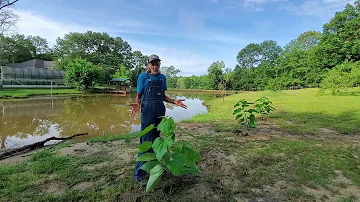
What are catalpa trees good for?

What are catalpa trees good for?
What Are Catalpa Trees Used For? Catalpas are mainly used for their ornamental features. They make excellent decorative plants for large areas including yards and parks. The large size and broad, heart-shaped leaves also make them great shade trees.
Can you eat catalpa beans?
The tree is famous for its long seed pods, which resemble beans or cigars. Despite the common name of « bean tree, » however, this catalpa has no known edible uses.
Are catalpas native?
Catalpa, commonly called catalpa or catawba, is a genus of flowering plants in the family Bignoniaceae, native to warm temperate and subtropical regions of North America, the Caribbean, and East Asia.
Are catalpas legumes?
The catalpa tree is the last tree to grow leaves in the spring. … The fruit is a long, thin legume-like capsule, 20–40 cm long and 10–12 mm diameter; it often stays attached to tree during winter (and can be mistaken for brown icicles). The pod contains numerous flat, light brown seeds with two papery wings.
How do you grow catalpa?
Choose a bright sunny location for growing Catalpa trees. Ideally, the soil should be moist and rich, although the plant can tolerate dry and inhospitable sites. Dig a hole twice as deep and twice as wide as the root ball. Fluff out the roots to the edges of the hole and fill in around them with well worked soil.
Are catalpa trees fast growing?
And with all of these unique features, the northern catalpa is popular with kids as well. While not ideal for every location, this unique and hardy tree is a fast grower that finds a home in parks and yards throughout the country.
Are catalpa pods hallucinogenic?
The name « catalpa » comes from the Native American tribe, Catawba of South Carolina, who smoked the bean pods. The pods are said to be hallucinogenic.
Do squirrels eat catalpa beans?
The catalpa belongs to a family that prefers warmer climates, like the jacaranda, and it is the only member of its family in the U.S. A redbud branch with seed pods. … Squirrels and birds love the red seeds, and come a snowy day, the robins will flock in and gorge.
What family is catalpa in?
Bignonias
Catalpa/Famille
Northern catalpa is a member of the Bignoniaceae, the Bignonia or Catalpa family. Species in this family range from woody vines to large trees. Other plants in the family include trumpet creeper (Campsis radicans) and crossvine (Bignonia capreolata). The family is mostly tropical and subtropical.
Where is the northern catalpa native to?
The catalpa tree is found in forests from southern Illinois and Indiana to western Tennessee and Arkansas. First cultivated in 1754, the wood was used for fence posts and railroad ties because of its resistance to rot and the tree’s fast growth rate.
What is the meaning of 'Catalpa'?
- Catalpa. Catalpa, commonly called catalpa or catawba, is a genus of flowering plants in the family Bignoniaceae, native to warm temperate and subtropical regions of North America, the Caribbean, and East Asia.
What is the Catalpa tree used for?
- Catalpa. Catalpa is a lovely low-spreading deciduous tree that can be used as a specimen tree in parks and gardens. It is valued for its large, showy leaves that are heart-shaped or three-lobed and often downy on their undersides.
What are Catalpa beans used for?
- Today, catalpa is used for the manufacture of fence posts, beams, furniture and millwork. Catalpa is also used as tonewood in the industry of guitars. Catalpa (seed) can be used in treatment of cardiac disorders, asthma and spasms. Catalpa is perennial plant that can survive around 70 years in the wild.
How do catalpa trees attract Catalpa worms?
- Since Catawba worms exclusively feed on the leaves of Catalpa trees, the best way to attract them is to have several healthy and leafy trees in one’s yard. Again, we have no idea what our reader’s situation is, but if her Catalpa trees aren’t in good health, this could certainly disincline the caterpillars from settling on her trees.
